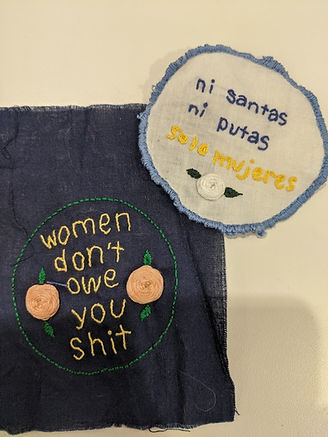
2019 Feminisms and Rhetorics Conference: DIY Feminist Activism
Harrisonburg Virginia
November 13-16, 2019

Curated Exhibits
We cannot hope to capture all the important stories from a four-day conference with nearly 500 participants. As archivists, we created seven curated exhibits that speak to a variety of key elements of FemRhet19:
1. Major Events
3. Sessions
5. Social Media

Curator Statement
Our interdisciplinary class of 18 James Madison University undergraduate students spent the Fall 2019 semester studying feminist rhetorics in preparation for our work as archivists on this project. The 2019 Feminisms and Rhetorics Conference (see conference website at http://femrhet2019.cwshrc.org/) was our introduction to feminist curation and archiving. We prepared for this archival project by studying generations of feminist rhetors and analyzing strategies they implemented in their work, researching archive examples that we admire, and having open discussions concerning our priorities for documenting this conference and curated items gifted to us.
We spent most of our energy gathering and creating content for this website. We hope the website - which includes a variety of donated artifacts as well as curated exhibits from the conference - is an organized and accessible space for conference information to live publicly. But we recognize that time, our own technological limitations and other challenges impacted our archive creation. With just over two weeks remaining in our academic semester after the conference ended, we approach this project as a DIY, on-the-fly archive that attempts to curate parts of the conference experience while necessarily leaving out or missing many aspects, voices and perspectives. We acknowledge this archive as one shaped by our own positionalities as students and feminists, as mostly white, socio-economically privileged, regionally located, straight and gay, activists and non-activists.
About this Archive
From the hundreds of donated, found and created digital artifacts, we created six curated exhibits we feel in some way capture an important aspects of the conference. We also organized various modes including flyers, Powerpoint presentations, bibliographies, images and videos to form a digital archive of items related to the conference.
Through our curating process, we attempted to capture the conference in an honest and inclusive way. However, we understand we will never be able to do this fully, as our class will not be able to experience every single moment of the conference from each conference goer’s perspective. Guided by the work of Nancy Deutsch (2004) and others who discuss the importance of "positionality" in scholarship, we endeavored to account for our own positionality as archivists and feminists mainly be being aware of ways that positionality would color our reading of the conference.
INVITED SPEAKERS

Digital Collections
Artifacts generously donated by dozens of presenters and conference attendees - including images, flyers, digital presentations, worksheets, bibliographies, and more - can be found integrated into the Curated Exhbits and also are the listed in the charts below. Original artifacts remain in the original Google folders created for sharing artifacts. Artifacts have been divided into five categries:
1. Images
2. Flyers
4. Videos
The Conference By the Numbers
46 states were represented this year.
The map below shows the location of the 478 attendees at this year's conference with more than 200 universities represented and several community organizations. Nearly 30 percent of those registered were graduate students or adjunct or part-time faculty and 39 participants were undergraduates.
Submissions
Our team endeavored to archive artifacts, experiences and reflections from the conference. Conference participants might have seen members of our class taking pictures, recording videos or gathering information during the conference. Other items and texts – including everything from PowerPoint presentations to guidelines for future craftivist projects – were submitted to the archive by conference goers themselves via Google folders set up to encourage participatory archiving.
To honor the Do It Yourself theme of the conference and this archive, we sought to incorporate all submissions that were gifted to us. Some are included in Curated Exhibits and others are included in the five categories of Digital Collections. We thus offer readers two options for engaging the archival materials – either via exhibits or in simple charts containing links to artifacts housed in the original Google folders.


